Information Extraction of High-Resolution Remotely Sensed Image Based on Multiresolution Segmentation
Abstract
:1. Introduction
2. Principle and Methods
2.1. Multiresolution Segmentation
 , no1,
, no1,  , no2, The weight of the band is ωc, then the combined area nmerge and variance σcmerge of the region are shown in Formula (3):
, no2, The weight of the band is ωc, then the combined area nmerge and variance σcmerge of the region are shown in Formula (3):




2.2. Information Extraction
- (1)
- Spectral featuresThe common spectral features include the mean value, brightness and standard deviation. The mean value is obtained by calculating all values of pixels of the image object layers. Brightness refers to the sum of the layers average value divided by the number of the image object layers. The Standard deviation is calculated by all pixels in one object layer.
- (2)
- Geometrical featuresGeometric features are based on the spatial distribution statistics of pixels constituting the image object. Covariance matrix can be used as a core tool for statistical treatment. If X and Y are constituted the image object x and y coordinates respectively, then the covariance matrix can be described as follows:
3. Information Extraction
3.1. Study Area and Data Sources
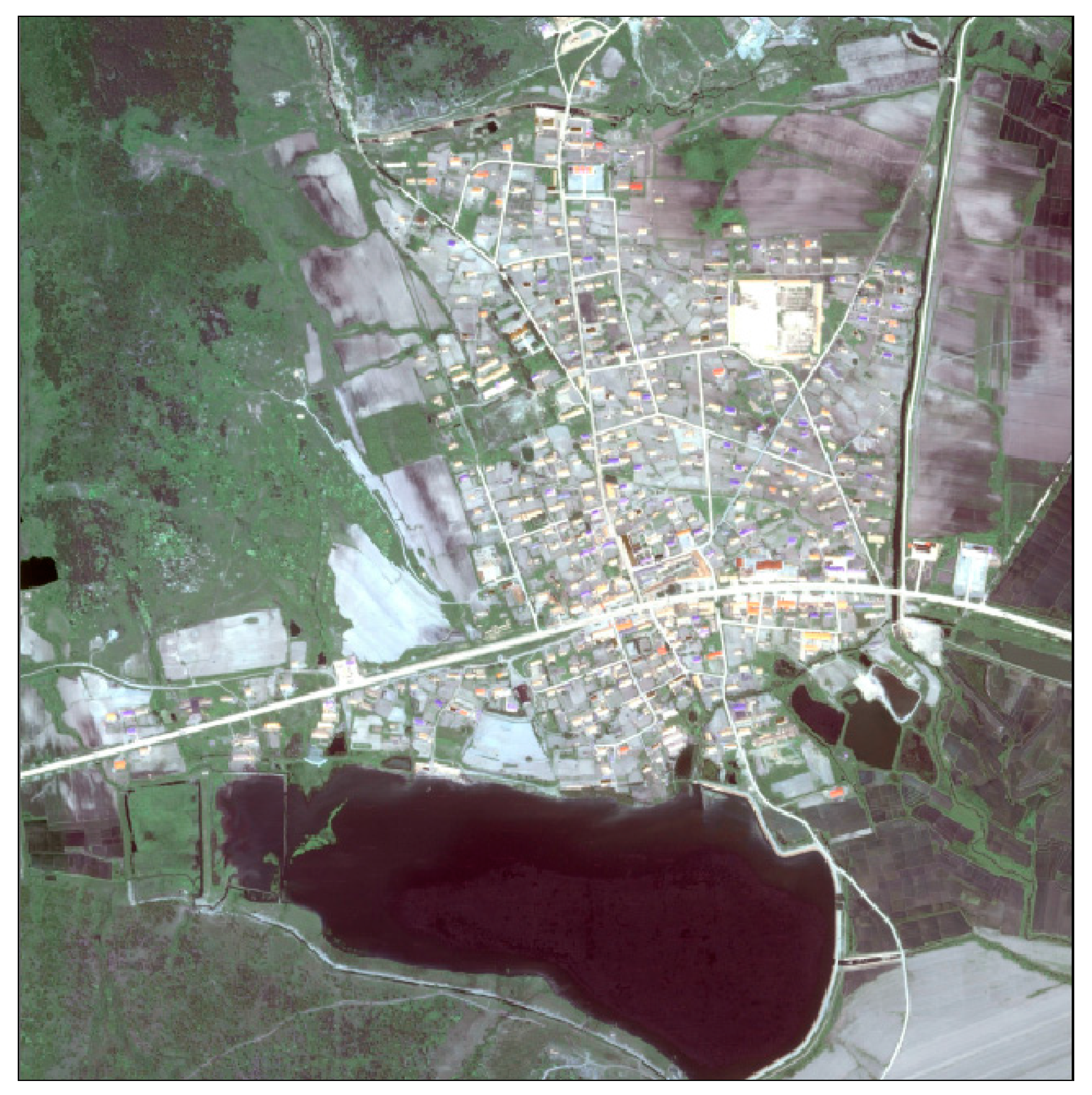
3.2. Multiresolution Segmentation
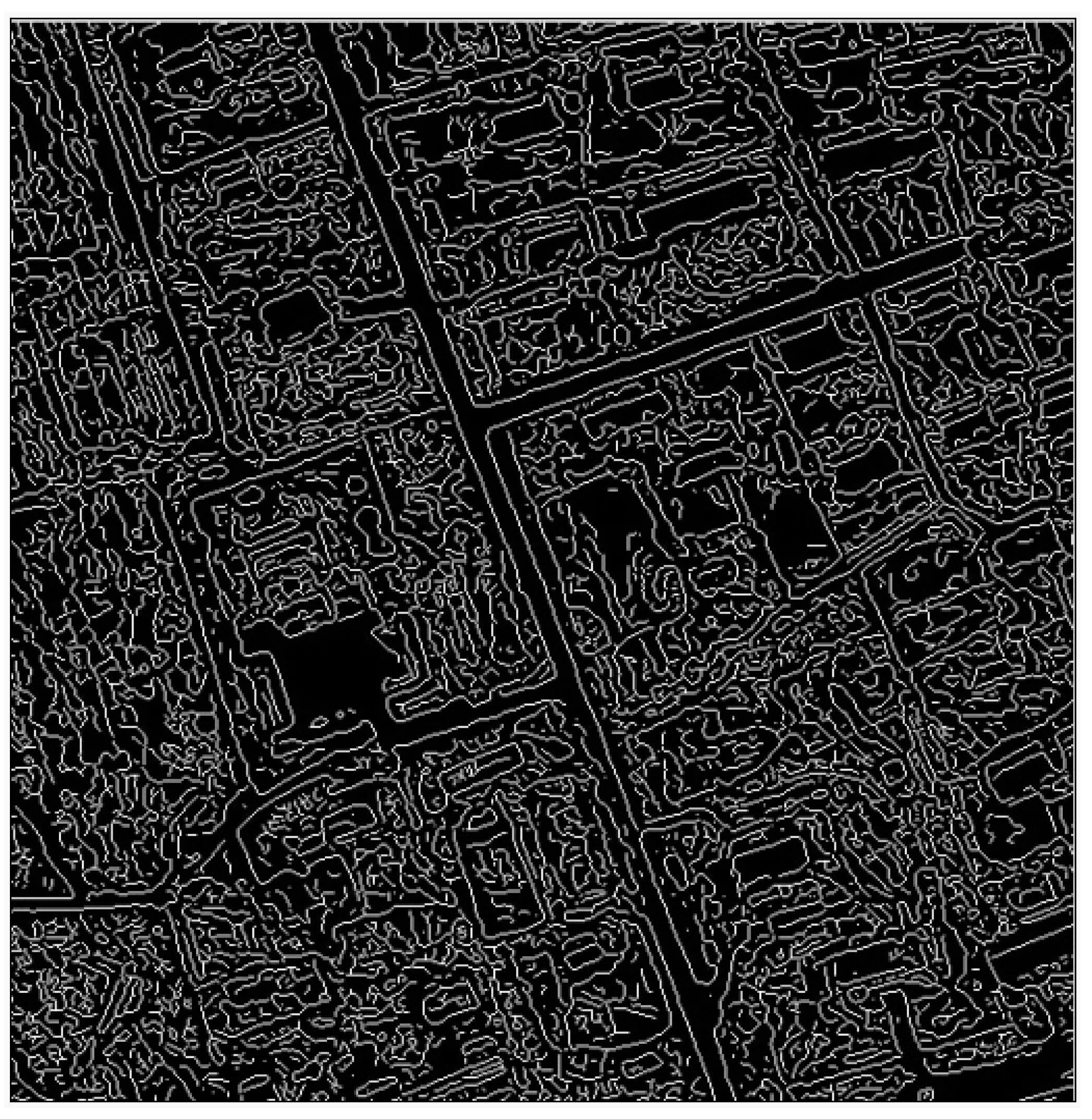
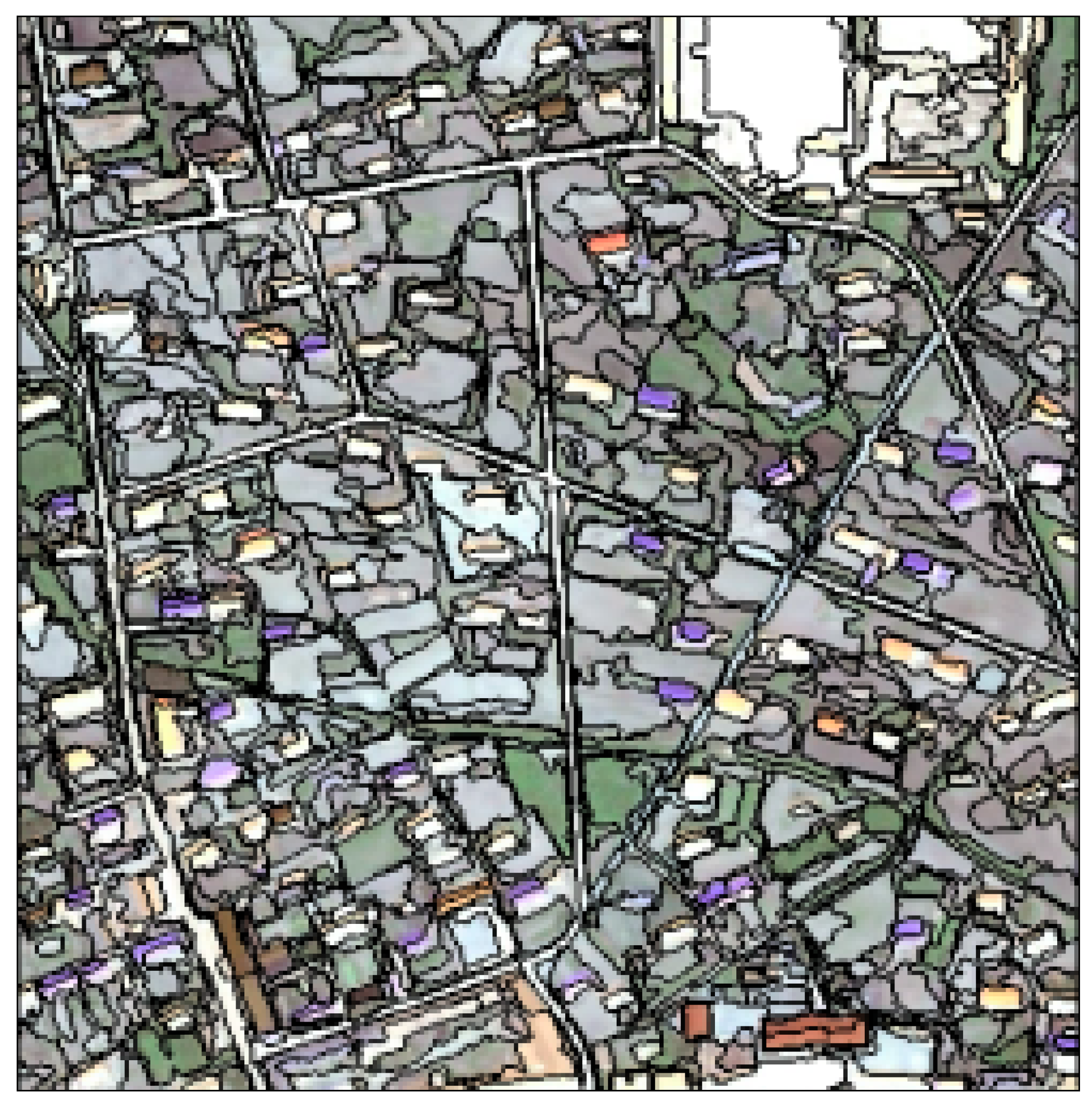
3.3. Main Features Extraction
3.3.1. Water Body Extraction

3.3.2. Vegetation Extraction

3.3.3. Road Extraction
3.3.4. Residential Areas Extraction
3.3.5. Bare Land and Other Extraction
| Information Category | Extraction Rules |
|---|---|
| Water | B is more than0.04, Layer 3 is less than 84 |
| Vegetation | G is more than0.34, Layer 3 is less than 80 |
| Road | Shape index is more than7, Compactness is more than 6, density is less than1, Length/width is more than 6 |
| Residential area | Brightness is more than140,Shape index is more than 5, rectangular fit is more than 0.5 |
| Bare Land | Brightness more is than120, B is more than −0.03 |
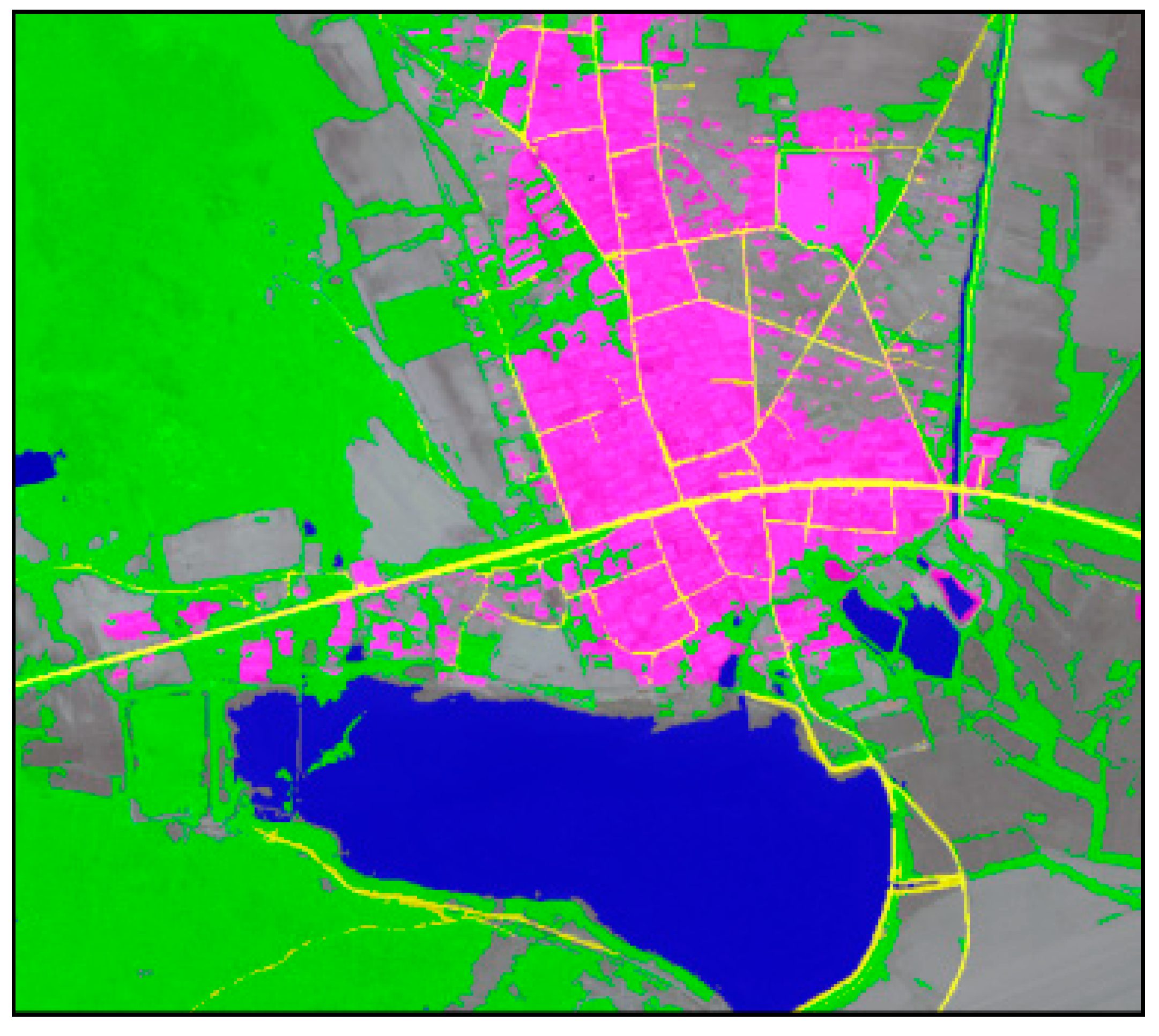
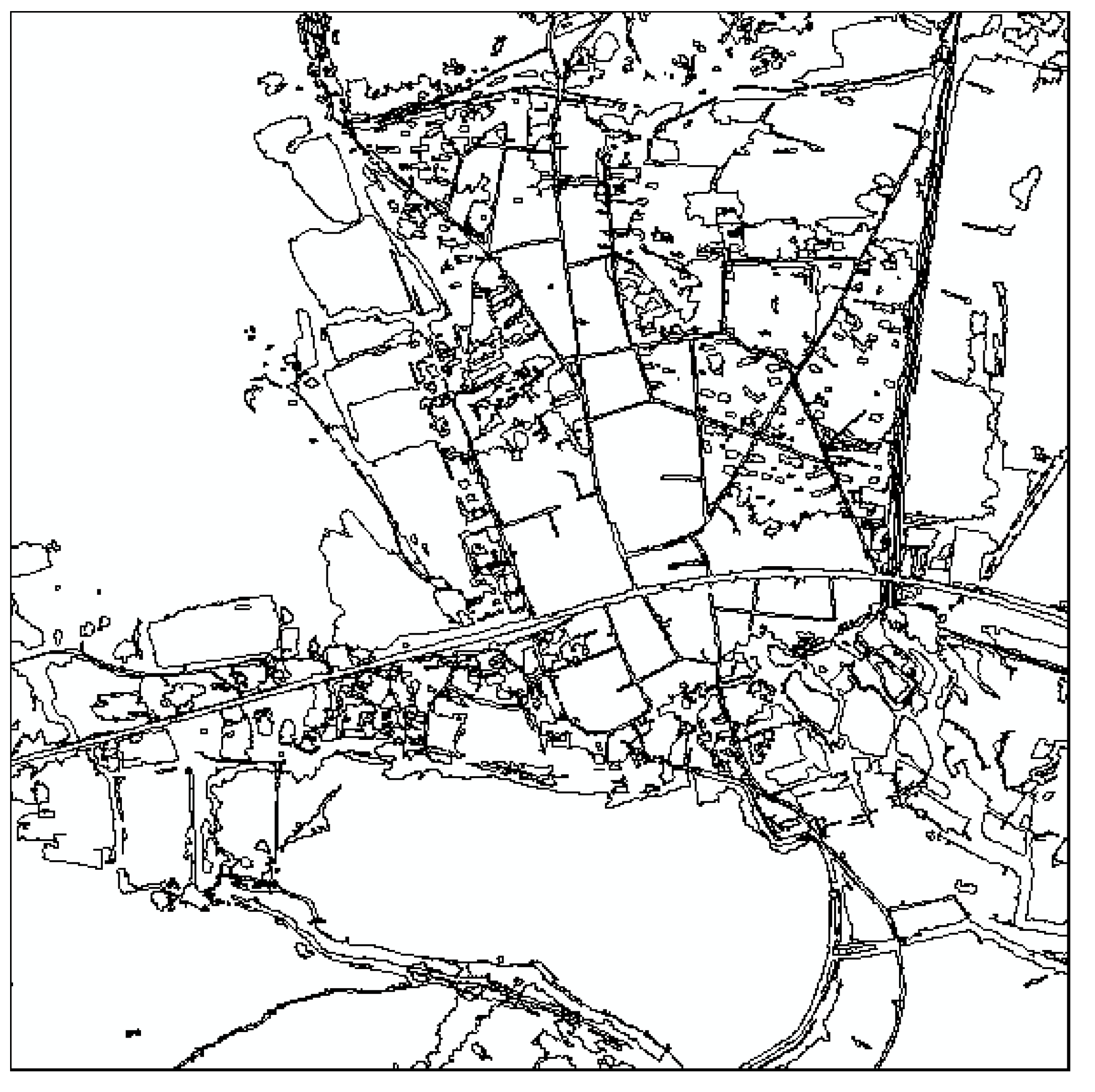
3.4. Accuracy Analysis
| Use class | Water | Vegetation | Road | Bare Land | Residential | Sum |
|---|---|---|---|---|---|---|
| Water | 97 | 0 | 0 | 0 | 0 | 97 |
| Vegetation | 0 | 177 | 1 | 11 | 2 | 191 |
| Road | 0 | 0 | 78 | 0 | 1 | 79 |
| Bare Land | 0 | 0 | 2 | 171 | 0 | 173 |
| Residential | 0 | 0 | 4 | 7 | 126 | 133 |
| Sum | 97 | 177 | 85 | 189 | 127 | |
| Accuracy | ||||||
| Producer | 1 | 1 | 0.918 | 0.905 | 0.913 | |
| User | 1 | 0.926 | 0.987 | 0.94 | 0.92 | |
| Kappa | 1 | 1 | 0.907 | 0.87 | 0.891 | |
| Totals | ||||||
| Overall Accuracy | 0.946 | |||||
| Kappa | 0.931 | |||||
4. Conclusions
Acknowledgments
Author Contributions
Conflicts of Interest
References
- Willhauek, G. Comparison of object oriented classification techniques and standard image analysis for the use of change detection between SPOT multispectral satellite images and aerial photos. In Proceedings of XIX ISPRS Congress, Amsterdam, The Netherlands; 2000; pp. 35–42. [Google Scholar]
- Hofmann, P. Detecting informal settlements from IKONOS data using methods of object oriented image analysis-an example from Cape Town (South Africa). Available online: http://www.ecognition.com/sites/default/files/395_hofmann.pdf (accessed on 29 May 2014).
- Gong, P.; Li, X.; Xu, B. Interpretation theory and application method development for information extraction from high resolution remotely sensed data. J. Remote Sens. Beijing 2006, 10, 1–5. [Google Scholar]
- Marangoz, A.M.; Oruc, M.; Buyuksalih, G. Object-oriented image analysis and semantic network for extracting the roads and building s from IKONOS pan-sharpened images. In Proceedings of the XXth Congress of International Society for Photogrammetry and Remote Sensing, Istanbul, Turkey; 2004; pp. 12–23. [Google Scholar]
- Cheng, L.; Gong, J. Building Boundary Extraction Using Very High Resolution Images and Lidar. Acta Geodaetica et Cartographica Sinica 2008, 37, 391–393. [Google Scholar]
- Im, J.; Jensen, J.R.; Tullis, J.A. Object-based change detection using correlation image analysis and image segmentation. Int. J. Rem. Sens. 2008, 29, 399–423. [Google Scholar] [CrossRef]
- Benz, U.C.; Hofmann, P.; Hofmann, P.; Willhauek, G. Mufti-resolution object-oriented fuzzy analysis of remote sensing data for GIS-ready information. P&RS 2004, 58, 239–258. [Google Scholar]
- Baatz, M.; Schäpe, A. Multiresolution segmentation: An optimization approach for high quality multi-scale image segmentation. In Angewandte. Geographische. Informationsverarbeitung XII; Wichmann Verlag: Karlsruhe, Germany, 2000; pp. 12–23. [Google Scholar]
- Zheng, J.; Shi, Y.; Qin, Y. Building Extraction from High Resolution Satellite Imagery Based on Multi-Scale Image Segmentation and Model Matching. In Proceedings of International Workshop on Earth Observation and Remote Sensing Applications, Beijing, China; 2008; pp. 1–7. [Google Scholar]
- Mueller, M.; Segl, K.; Kaufmann, H. Edge-and region-based segmentation technique for the extraction of large, man-made objects in high-resolution satellite imagery. Pattern Recogn. 2004, 37, 1619–1628. [Google Scholar] [CrossRef]
- Myint, S.W.; Gober, P.; Brazel, A.; Grossman-Clarke, S.; Weng, Q. Per-pixel vs. object-based classification of urban land cover extraction using high spatial resolution imagery. Remote. Sens. Environ. 2011, 115, 1145–1161. [Google Scholar]
- Herold, M.; Scepan, J.; Müller, A.; Günther, S. Object-oriented mapping and analysis of urban land use/cover using IKONOS data. In Proceedings of 22nd Earsel Symposium Geoinformation for European-Wide Integration, Prague, Czech Republic; 2002; pp. 4–6. [Google Scholar]
- Baatz, M.; Schäpe, A. Object-oriented and multi-scale image analysis in semantic networks. In Proceedings of 2nd International symposium: Operationalization of remote sensing, Enschede, The Netherlands; 1999; pp. 16–20. [Google Scholar]
- Du, F.; Tian, Q.; Xia, X. Object-oriented feature classification analysis and evaluation. J. Remote. Sens. Tech. Appl. 2004, 19, 20–24. [Google Scholar]
- Stow, D.; Lopez, A.; Lippitt, C.; Hinton, S; Weeks, J. Object-based classification of residential land use within Accra, Ghana based on QuickBird satellite data. Int. J. Rem. Sens. 2007, 28, 5167–5173. [Google Scholar]
- Sun, X.; Zhang, J.; Liu, Z. Using the object-oriented classification method from IKONOS panchromatic images to extract the rivers and roads. Sci. Surv. Mapp. 2006, 31, 62–63. [Google Scholar]
- Zhou, C.; Wang, P.; Zhang, Z. Based on object oriented city coin land use classification information extraction technology. Remote Sens. Tech. Appl. 2008, 23, 31–35. [Google Scholar]
- Tao, C.; Tan, Y.; Cai, H. Object-oriented high-resolution remote sensing image of city building hierarchical extraction method. J. Surv. Mapp. 2010, 39, 39–45. [Google Scholar]
© 2014 by the authors; licensee MDPI, Basel, Switzerland. This article is an open access article distributed under the terms and conditions of the Creative Commons Attribution license (http://creativecommons.org/licenses/by/3.0/).
Share and Cite
Shao, P.; Yang, G.; Niu, X.; Zhang, X.; Zhan, F.; Tang, T. Information Extraction of High-Resolution Remotely Sensed Image Based on Multiresolution Segmentation. Sustainability 2014, 6, 5300-5310. https://doi.org/10.3390/su6085300
Shao P, Yang G, Niu X, Zhang X, Zhan F, Tang T. Information Extraction of High-Resolution Remotely Sensed Image Based on Multiresolution Segmentation. Sustainability. 2014; 6(8):5300-5310. https://doi.org/10.3390/su6085300
Chicago/Turabian StyleShao, Peng, Guodong Yang, Xuefeng Niu, Xuqing Zhang, Fulei Zhan, and Tianqi Tang. 2014. "Information Extraction of High-Resolution Remotely Sensed Image Based on Multiresolution Segmentation" Sustainability 6, no. 8: 5300-5310. https://doi.org/10.3390/su6085300
APA StyleShao, P., Yang, G., Niu, X., Zhang, X., Zhan, F., & Tang, T. (2014). Information Extraction of High-Resolution Remotely Sensed Image Based on Multiresolution Segmentation. Sustainability, 6(8), 5300-5310. https://doi.org/10.3390/su6085300





